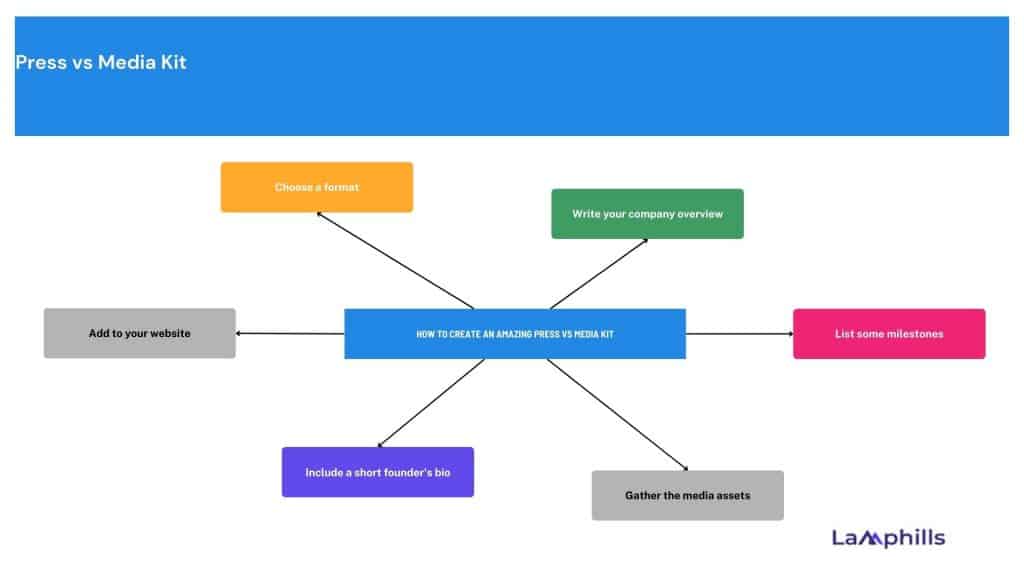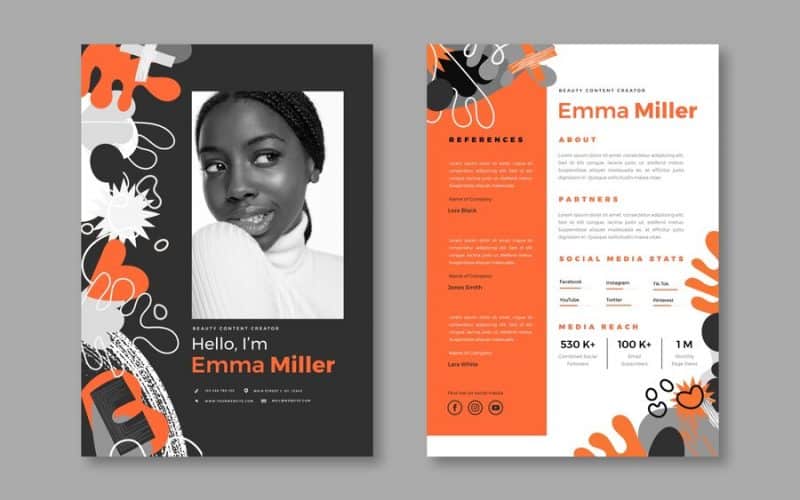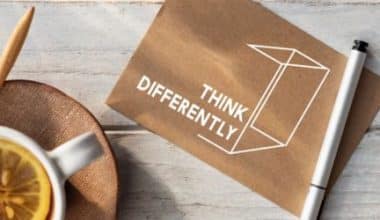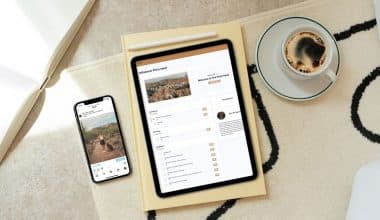Have you ever felt like you’re drowning in confused marketing terms? You are not alone! As a public relations practitioner for almost a decade, I’ve seen several clients mistake the seemingly similar terms “press kit” and “media kit.” But don’t worry, because today I’ll clear the air and equip you with the knowledge you need to dominate the public relations battlefield! So, settle back, and let’s explore a press vs a media kit. Buckle up, because we are about to become experts!
Let’s address the elephant in the room – is there even a difference? Honestly, it’s a bit of a grey area. Traditionally, a press kit catered specifically to journalists, offering information about a company, a new product launch, or a noteworthy event. Think of it as a journalist’s one-stop shop for crafting compelling stories.
On the other hand, the media kit broadened its scope. It still provided information about the company and also targeted bloggers, influencers, and other content creators alongside journalists. It’s like a PR Swiss Army Knife – versatile and adaptable to different audiences. Many PR professionals now use the terms interchangeably. The key takeaway? Regardless of the label, understand who your target audience is and tailor your content accordingly.
Key Points
Here are 4 key takeaways:
- Traditionally, a press kit targeted journalists with information about a company, launch, or event. A media kit broadened the scope to include bloggers, influencers, and other content creators. The key takeaway is to tailor the content to your target audience (journalists vs. broader media).
- A press kit typically includes a compelling press release, company backgrounder, high-resolution images, and media contact information. A media kit expands on this with social media links, case studies, blog posts, and brand assets.
- Regardless of the type of kit, prioritize clarity, conciseness, and visual storytelling. Keep your kit up-to-date, ensure mobile-friendliness, and consider using interactive elements or cloud-based access for media kits.
- Both press kits and media kits are valuable tools for communication and promotion. Use a press kit to target journalists for news coverage, and a media kit to attract a wider range of media channels and stakeholders for partnerships and collaborations.
Difference Between Press Kit vs. Media Kit
Now that we’ve covered the fundamentals, let’s look more closely at the differences between these two titans.
Press kit
Consider yourself a journalist on a mission to unearth the next big story. You come across a press kit brimming with enticing press releases, high-resolution images, and useful company information. In a world overflowing with pitches and press releases, a well-crafted press kit stands out like a beacon of hope, delivering everything a journalist needs to create a great story.
As a PR professional, I’ve personally seen how a well-curated press kit influences media coverage. During a product launch event, I created a press kit that captured the soul of the brand and the ingenuity that drove the product. The result? Extensive media coverage and feature articles in leading industry publications.
Media Kit
Now imagine yourself as a marketer looking for possible sponsors or collaborators for your business. You pull out your media kit, which is jam-packed with audience demographics, social media reach, and engagement statistics. With appealing facts and compelling content, your media kit can be a powerful tool for attracting partners and securing profitable collaborations.
While working for a fashion startup, I created a media kit detailing our brand’s unique selling qualities, target audience demographics, and social media engagement statistics. Armed with this strong tool, we were able to obtain collaborations with influencers and fashion bloggers, resulting in greater brand visibility and sales.
Importance of Press Kit vs Media Kit
The terms “press kit” and “media kit” are often used interchangeably as I have previously stated, but there can be subtle differences in their intended audiences and purposes:
Press Kit: Traditionally, a press kit is geared towards members of the press or journalists. It provides them with the necessary resources and information to write articles, create news stories, or cover events related to the subject of the kit. Press kits typically focus on providing news angles, press releases, high-resolution images, and other assets that journalists can use to develop their own stories.
Media Kit: A media kit, on the other hand, is a broader term that encompasses not only traditional press materials but also information targeted towards a wider range of media outlets and stakeholders. In addition to catering to journalists, a media kit may include materials aimed at bloggers, social media influencers, potential partners, advertisers, or investors. It can provide a comprehensive subject overview, including company background, product details, audience demographics, advertising rates, sponsorship opportunities, and more.
In essence, while a press kit focuses primarily on providing resources for journalists to generate news coverage, a media kit may have a broader scope, catering to various media channels and stakeholders involved in promoting or interacting with the subject.
Both press kits and media kits are important tools for communication and promotion, helping organizations and individuals disseminate information, build relationships with the media, and shape their public image. The choice between using a press kit or a media kit often depends on the specific goals, target audience, and context of the communication strategy.
Press Kit vs Media Kit Mistakes to Avoid
- Don’t forget to cite your sources. Journalists enjoy data and facts, especially when presented in a way that explains your brand’s importance. Don’t include statistics in your press kit without providing sources and attribution; it will only make you appear less trustworthy.
- Don’t use trendy slang; it will only make you and your organization appear outdated. Is your product fashionable? I didn’t think so.
- Avoid cutting and pasting without first reviewing. If someone committed a mistake in the early days of your business, don’t be the person who continues to include it in updated information.
- Don’t make your contact information difficult to find. There’s nothing more aggravating to a journalist than heading to a website of a potentially fascinating source and getting lost in links without contact info.
What to Include in Making a Media Kit vs Press Kit
So you want press coverage and partnerships (what brand doesn’t?). You realize how a media kit or press kit makes this all feasible. But, how do you create a media kit vs a press kit?
Here’s some good news: most of the content and creative assets you’ll need to develop your press kit or media kit are likely already available.
A media kit should include a biography or About Us page, social media statistics, case studies, partnerships and collaborations, and testimonials. To make it easy for the press to cover your work, offer high-quality brand identity images (such as logos, other brand images, or product/service images).
It is up to you to (1) find this information, (2) make it visually appealing, and (3) make it painfully easy to find on your website. Have you heard reports about journalists being overworked? This is entirely accurate.
To grab the attention of someone on a tight schedule with an internet full of story ideas, you’ll want to keep it basic. Most brands use a straight page name like “Press” or “Media” — or, if they’re fancy, “Newsroom” — and link to it from their homepage (typically in the Footer).
Even if you prefer a web version, a downloadable media kit or deck is well worth the effort invested. Some media users might prefer the old form of this site, which gives you the best opportunity to control your pitch and tailor content to all audiences.
Download Press kit Vs Media kit Checklist
How to Create an Amazing Press vs Media Kit

Now that you know what goes into your press kit vs media kit, let’s look at how you can create one for your business.
#1. Choose a format
Before you pick any testimonials or About Us content, consider how you intend to make your media kit available for press inquiries. Knowing your format allows you to create a collection of assets that attract the type of attention you seek.
For example, do you want journalists to contact your public relations team for your media kit or access it on their own? Will your kit include a list of downloadable elements to create a more immersive, interactive experience?
Format influences how people will present your brand. If you make your press materials easily accessible, you will most certainly receive more and better press coverage.
#2. Write your company overview.
Describe your brand and product in a few sentences. This can be an excellent spot to discuss your company’s mission statement and current goals.
You might also include:
- Founding date
- Location
- Size of company or number of employees
- Background information
- Press contact information
Keep your company’s details up to date. It’s most likely the first section of your press kit that a journalist will view.
#3. List some milestones.
Document your company’s achievements from inception until the present day, beginning with the most recent accomplishments. Mention milestones with the most valuable information about your company’s vision.
This section of your press kit could include details not addressed in your overview. Journalists will want to learn more about your company.
- Company background
- Fundraising stage
- Key features of your products
- Competitive advantages
- Your target audience
Help journalists understand how your company affects the market. Remember, they want to feature businesses that are relevant to their readers. So, if you precisely define your target audience, journalists with comparable demographics may be more likely to write about your company.
Download Press kit Vs Media kit Checklist
#4. Gather the media assets.
Your press kit should include assets that help journalists tell your company’s story. This includes:
- Company logo
- Images and headshots
- Testimonials
- Fact sheets
- Case studies
- Videos
- Press releases
- Publication logos
- Media mentions
- Team or product photos
Make sure your media assets are straightforward to download. You can use a file-sharing site such as Dropbox or group assets and allow journalists to download them to their computers.
#5. Include a short founder’s bio.
Personalize your company by including short biographies of your founders and other key staff members. Give journalists an overview of how it all began and what makes your team unique.
#6. Add to your website.
Whether you’re developing a downloadable or interactive press kit, publish it on your website. When searching for information, most journalists will go to the Press, Media, or Newsroom pages. Adding a press kit to your online business improves search engine optimization and increases traffic to your site.
Best Practices for Crafting Your Press Kit and Media Kit
Now that you understand the distinctions between a press kit vs a media kit, let’s explore some best practices for crafting these essential PR tools.
- Know Your Audience: Before diving into the nitty-gritty details, take time to understand your target audience and tailor your press kit and media kit to their preferences and interests.
- Keep it Concise: Journalists and collaborators don’t have time for lengthy documents. Keep your press kit and media kit concise, focusing on the most relevant information and assets.
- Visual Appeal: Incorporate high-quality images, infographics, and videos to make your press kit and media kit visually appealing and engaging.
- Update Regularly: Keep your press kit and media kit up to date with the latest information, statistics, and achievements to ensure they remain relevant and impactful.
- Accessibility: Make it easy for journalists and collaborators to access your press kit and media kit by providing multiple channels for distribution, such as email, website, and social media.
Download Press kit Vs Media kit Checklist
Press Kit Vs Media Kit Examples
If you need additional inspiration, check out these e-commerce businesses doing press kits or media kits right:
#1. Spotify
Spotify offers a special media kit that supports one of its core features, Streaming Intelligence. Media and other parties can go through the package to learn about the tool’s features, how it works, performance statistics, and partnerships with prominent sources that back up its success.
#2. Delta Airlines
Delta Airlines’ press kit is available on its website and includes everything you’d expect from one. Because it is such a vast organization, every section of the press kit is on its own site page, which users access by following a hyperlink.
#3. FiftyThree
FiftyThree’s media kit is heavily image-based. It showcases the brand’s awards, feature stories, and images of its founding crew. Journalists can download its press kit or logos right from the page, or contact its PR team for more information.
What is another name for a media kit?
A media kit, also known as a press kit, is a pre-packaged set of promotional materials that provides information about a business, product, or event.
What is the media kit?
A media kit, also known as a press kit, is a promotional package of information about a person, company, organization, or product that is distributed to members of the media for promotional purposes. It typically contains information and resources that journalists, bloggers, or other media professionals might find useful when writing about the subject.
What can be included in a press kit?
Here are a few things to include in a press kit vs media kit:
- Information
- Press releases
- Social media accounts and information
- Write your company overview
- Awards and recognition
- Gather your media assets
- Product samples
- Branding
- FAQs
Who needs a press kit?
Various entities and individuals can benefit from having a press kit, including:
- Companies and Businesses
- Nonprofit Organizations
- Authors and Writers
- Artists and Performers
- Public Figures and Personalities
Conclusion
As I conclude the discussion on a press kit vs a media kit, one question remains: which tool holds the key to your brand’s success? The truth is that both a press kit and a media kit are vital parts of your PR armory, having distinct purposes in pursuing media coverage and brand recognition. So, the next time you need PR or partnership, remember to use these crucial strategies to help your company reach new heights.
But I have a question for you: In your experience, which tool has proven more helpful for gaining media attention and securing collaborations: the press kit or the media kit? Share your ideas and experiences in the comments below!
Related Articles
- HOW TO CREATE A PRESS KIT WITH EXAMPLES AND FREE TEMPLATES
- Influencer Media Kit: Examples, Templates & Tips to Inspire You
- Press Release Examples to Inspire You in 2024 (+ Expert Tips & Templates)
- The Best 2024 PR Package Ideas & Everything You Need.






